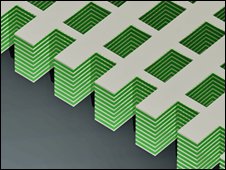'Slow light' helps speed up the Internet
British scientists say network traffic will increase significantly by slowing down some parts of it and using "super-materials" to replace bulky, slow-moving electrons in data routing.
Typically, high-speed telecommunication lines, including fiber-optic cables spanning large distances, carry a multitude of different streams of information on different channels with different light frequencies.
When the data is near its destination, the light frequencies will be separated to the destination. This separation must rely on a giant device that takes the relatively close frequency band in the pulse to different detectors.

Design of " metamaterial " metamaterial. Photo: BBC
The light is then converted into electromagnetic signals, stored, routed and converted back into optical signals by lasers. It is this transformation that makes the process complicated and expensive and reduces the speed of data transmission.
"Light and fiber can reach a few terahertz, but that conversion makes the whole process only a few gigahertz," said Dr Chris Stevens of Oxford University.
At this time, "super-matter" (metamaterial - material that has its structure-based characteristics and not its composition) is an effective solution. If the light signal can slow down during the conversion process, one does not need to undergo the conversion of electromagnetic signals. The optical properties of metamaterials are intended to slow down light, making it possible to store.
"The ability to slow down light will be a strong driving force for the telecommunications industry to increase speed and performance," said Professor Xiang Zhang of the University of California. "With metamaterials, one can imagine the prospect of a single chip that would operate the routing process while now relying on giant systems."
- The first time slow down the speed of light
- Please watch the video made by NASA to see how slow the speed of light is
- Slow down the speed of light
- 12 outstanding photos of slow speed art
- Things you don't know about the speed of light
- Launched a super speed camera of 100 billion fps, capturing light movement
- Internet download speed in Vietnam is on par with Qatar, Australia
- Slow-moving people lose memory more than usual
- How to use smartphones to detect people
- Fix the situation of Windows 10 computer slowly
- Detecting new forms of light increases Internet speed
- NASA's Internet speed rumor reaches 91 Gb / s, is it true to download movies in 1 second?
 What is the Snapdragon SiP chip?
What is the Snapdragon SiP chip? How to create a yellow circle around the mouse cursor on Windows
How to create a yellow circle around the mouse cursor on Windows Edit the Boot.ini file in Windows XP
Edit the Boot.ini file in Windows XP 3 ways to restart the remote computer via the Internet
3 ways to restart the remote computer via the Internet